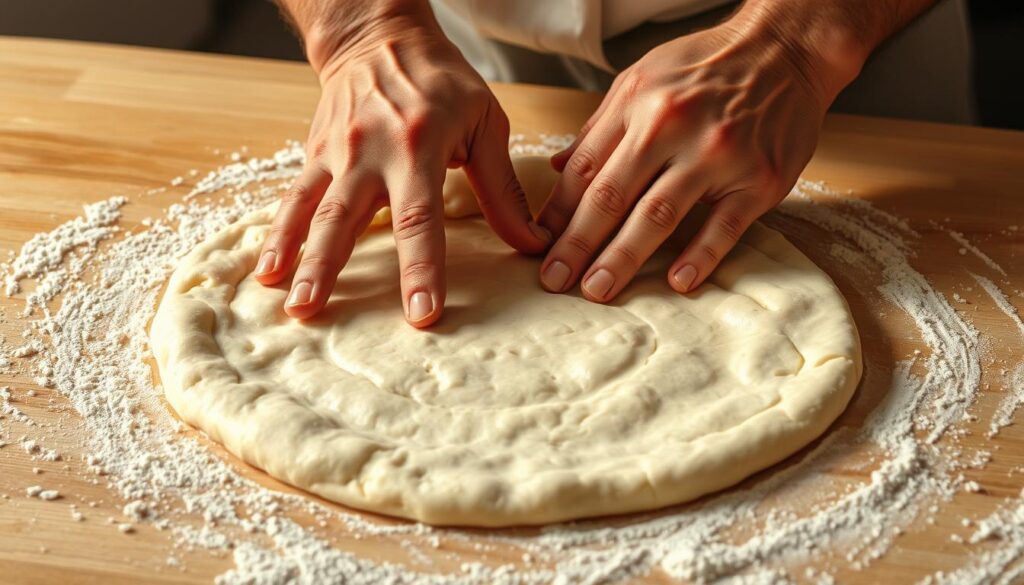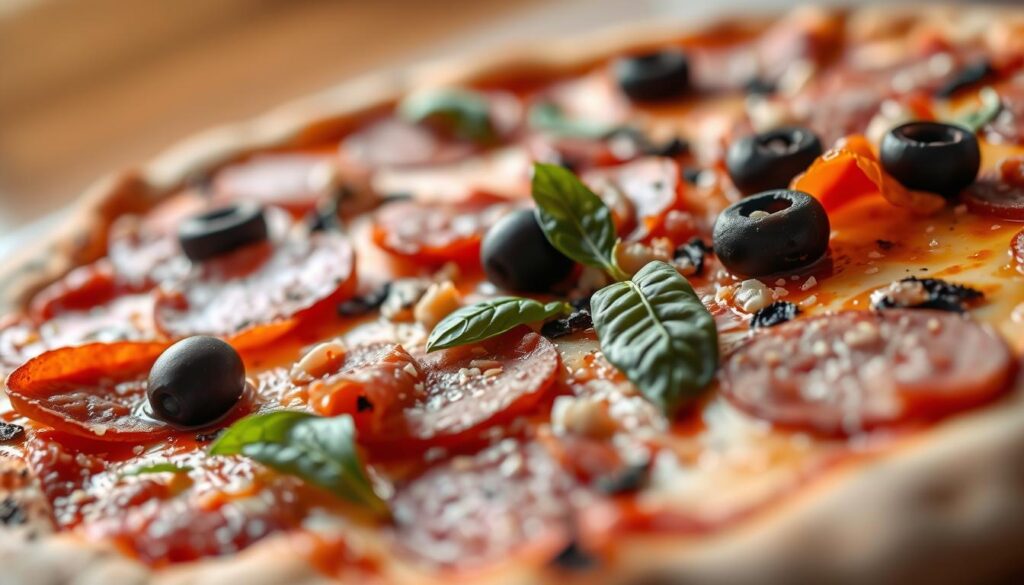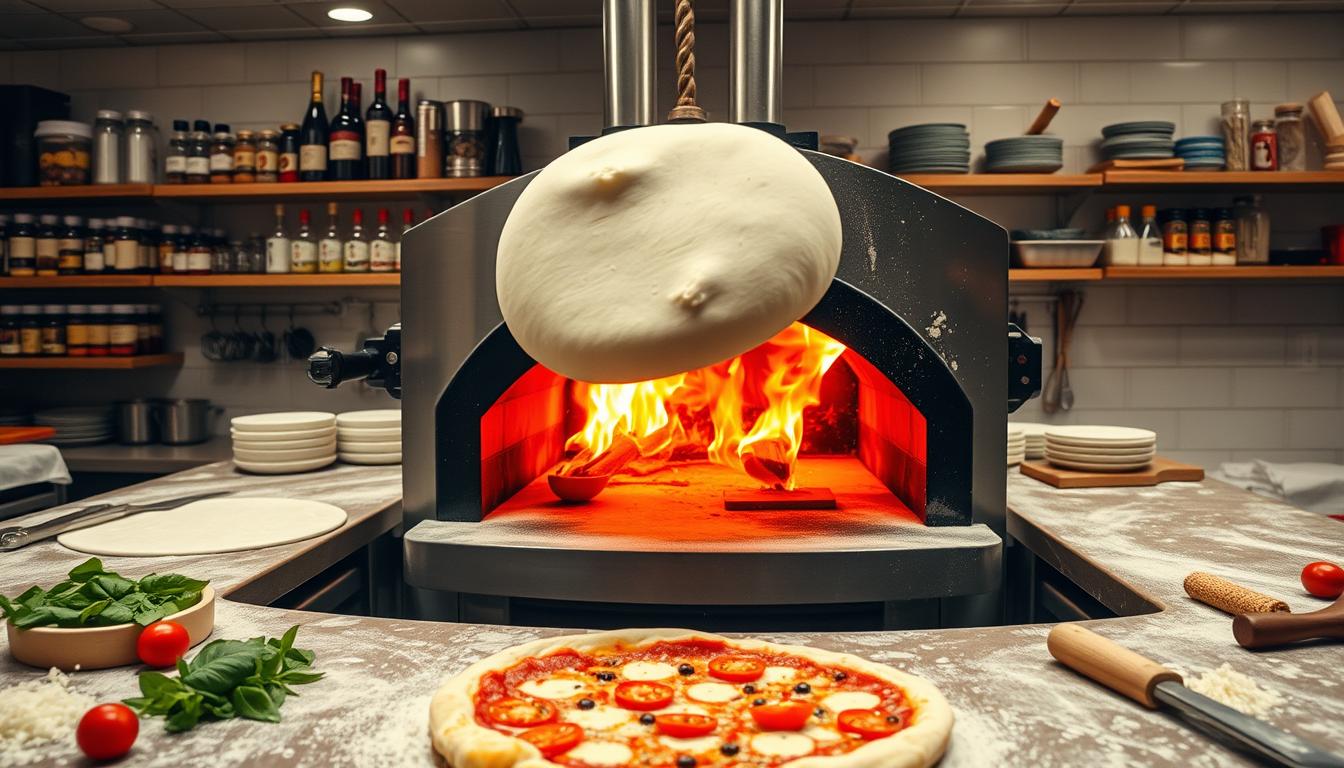Welcome to your ultimate guide on cooking pizza like a pro! This guide is for everyone, from beginners to pizza lovers. You’ll learn how to make delicious pizzas at home. We’ll cover everything from choosing the right ingredients to mastering cooking techniques.
Let’s explore pizza recipes and cooking techniques together. This guide makes creating tasty pizzas easy. You can aim for classic Neapolitan style or try unique toppings. We’ll give you the tools and knowledge for perfect pizzas every time.
Key Takeaways
- Master the basics of pizza recipes and cooking techniques
- Learn about different pizza styles and their unique characteristics
- Discover essential tips for perfecting your pizza dough
- Explore the best equipment and tools for home pizza making
- Understand how to select and prepare the perfect toppings
The Essential Elements of Perfect Pizza Making
Making a perfect pizza involves knowing the key elements that make it special. Whether you’re new to cooking or have experience, learning these basics will improve your pizza-making skills. Let’s explore the main parts that make great pizza, from the styles to the ingredients.
Understanding Pizza Styles
Pizza styles are diverse, each with its own unique traits. You might prefer the thin, crispy crust of New York-style or the thick, doughy slices of Chicago deep-dish. Exploring these styles helps you find the one that suits your taste best. Try Neapolitan for its soft crust or Sicilian for its hearty dough.
Basic Components of Great Pizza
The heart of a great pizza is its components. Start with the crust, whether it’s thin, thick, or somewhere in between. Choose a sauce that fits your style, like a classic tomato sauce or a white sauce. Mozzarella cheese is essential, and fresh toppings add the final touch. Remember, less is more, as simplicity can enhance flavor.
- Crust: The base that defines your pizza’s texture
- Sauce: The flavor backbone of your creation
- Cheese: The creamy, melty heart of your pizza
- Toppings: The finishing touches that make it unique
Professional Standards to Aim For
To reach professional pizza standards, focus on quality and technique. Use fresh, local ingredients whenever you can. Pay close attention to the dough’s texture and fermentation. Practice stretching and assembling to ensure even cooking. Consistency is crucial, whether making one pizza or many.
By mastering these elements, you’ll be well on your way to making pizzas as good as those from top pizzerias. Experiment with different styles, refine your ingredients, and aim for professional standards. With practice, you’ll unlock the secrets to making pizzas that are both delicious and impressive.
Mastering Your Pizza Dough
To make a tasty pizza, you need to master your pizza dough. You must know about flour, yeast, and water. Also, learn how to mix, knead, and let it rise. With time and effort, you’ll get better at making great pizza dough.
The flour you choose is key for your pizza dough. Use flour with high protein, like bread flour or high-protein all-purpose flour. The right yeast and water are also crucial. They make the dough easy to work with and help it rise well.
There are many dough recipes and dough techniques to try. Some add a tangy flavor with a sourdough starter. Others use a mix of all-purpose and whole wheat flour for a richer taste. Try different recipes and techniques to find what works best for you.
Here are some tips for mastering your pizza dough:
- Use high-quality ingredients, including fresh yeast and unbleached flour
- Keep the dough at room temperature, away from drafts and extreme temperatures
- Let the dough rise for at least 24 hours to allow for proper fermentation
- Use a gentle touch when handling the dough to avoid over-working it
Choosing the Right Equipment for Cooking Pizza
Creating the perfect pizza starts with the right tools. Whether you’re a pro or a home cook, the right equipment can make a big difference. Let’s look at the key items you need to make restaurant-quality pizzas at home.
Pizza Stones vs. Steel
Pizza stones and steel are top choices for a crispy crust. Stones, made from materials like cordierite, absorb moisture and spread heat well. They’re a classic choice. Steel, on the other hand, retains heat fast and cooks evenly. It’s great for quick, high-temperature baking. Your choice depends on your cooking style and what you like.
Ovens and Temperature Requirements
The right oven is key for baking pizza. Home ovens usually can’t get as hot as professional ones. To get that pizzeria taste, use a pizza steel or stone to help your oven reach the best temperature. Aim for a baking temperature of 450°F to 500°F. Experiment to find the perfect temperature for your crust.
Essential Tools and Accessories
There are many tools that can improve your pizza-making. A pizza peel is essential for moving dough and pies safely. A pizza wheel makes clean cuts, and a thermometer ensures toppings are cooked right. Also, a good cutting board and spatula are great for serving and decorating.
With the right equipment, you can make delicious pizzas at home. Choose between pizza stones and steel based on your cooking style. Add the right oven and accessories, and you’re on your way to making perfect pizzas.
Selection and Preparation of Pizza Toppings
Choosing the right topping selection is key to a tasty homemade pizza. There are many ingredients to pick from, making it hard to decide. Fresh veggies, meats, and cheeses are all good choices. For ideas, check out pizza recipes online.
Getting each topping ready is important. Slice, dice, and chop to get the right texture and taste. Popular toppings include pepperoni, mushrooms, and olives. Try mixing different toppings to make unique pizzas that you’ll love.
Here are some tips for getting your toppings ready:
- Choose fresh and high-quality ingredients
- Prepare ingredients according to their texture and flavor profile
- Experiment with different combinations to find your perfect match
Homemade pizza is all about trying new things and being creative. Don’t hesitate to experiment with topping selection and topping preparation. With practice, you’ll make delicious pizzas with your favorite pizza toppings.
The Science Behind Perfect Pizza Sauce
Making the perfect pizza sauce is an art that needs the right ingredients and techniques. Whether you’re new or experienced, mastering pizza sauce can make your homemade pizza better. Let’s explore how to make a sauce that goes well with your dough and toppings.
For classic tomato sauce recipes, keep it simple. Use high-quality tomatoes, fresh or canned, and add garlic, olive oil, and a bit of sugar. Try herbs like basil or oregano to match your taste. For more tips, check out this guide on making homemade pizza.
Classic Tomato Sauce Recipes
A good tomato sauce is key for many pizza styles. Here’s a basic recipe to start with:
- 2 cups of crushed tomatoes
- 2 tablespoons of olive oil
- 2 cloves of minced garlic
- 1 teaspoon of sugar
- 1 teaspoon of dried basil
- Salt and pepper to taste
Sauté the garlic in olive oil, then add the tomatoes. Simmer for 20-30 minutes. Season with sugar, basil, salt, and pepper. This makes a rich, flavorful base for any topping.
Alternative Sauce Options
Tomato sauce is classic, but try alternative sauce options too. Pesto, white garlic sauce, or spicy arrabbiata can spice up your pizza. Each offers a unique flavor, perfect for different tastes or diets. For example, a white sauce with garlic, olive oil, and Parmesan is great for a lighter pizza.
| Sauce Type | Description | Best Use |
|---|---|---|
| Tomato | Rich and tangy | Classic Neapolitan or Margherita pizzas |
| Pesto | Herbaceous and creamy | Vegetarian or vegan pizzas |
| White Garlic | Garlicky and buttery | Seafood or cheese-heavy toppings |
Sauce Application Techniques
How you apply the sauce matters a lot. Use a sauce technique for even coverage without drowning the dough. A thin layer is best for most pizzas, letting the toppings and crust stand out. For Neapolitan-style, a light sauce is perfect; for heavy toppings, a thicker layer works better.
Remember, practice makes perfect. Feel free to adjust recipes and techniques to your liking. With the right approach, your pizza sauce will be the highlight of your homemade pizzas.
Professional Techniques for Stretching Dough
To get a perfect crust, dough stretching is key in making great pizza. It’s about knowing the different dough types and how temperature and humidity affect it. By learning dough techniques, you can make a delicious, authentic pizza crust. It will surely impress your loved ones. For tips on improving your pizza-making, check out discover the perfect pizza at home.
Important things to think about when stretching dough include:
- Using the right amount of yeast for proper fermentation
- Letting the dough rest and relax for easier shaping and stretching
- Applying the right pressure and tension for the crust thickness you want
With practice and patience, you can get better at professional dough handling. Always handle the dough gently. Rough handling can make the crust tough and dense.

Temperature Control and Cooking Methods
Mastering pizza making is more than just ingredients. It’s about knowing temperature and cooking methods. Whether you use a wood-fired oven, gas, or electric, controlling heat is key. Knowing the best techniques for each oven type is crucial for a perfect pizza.
Different Oven Types
Choosing the right oven is important for your pizza. Here’s a quick guide to popular oven types:
- Wood-Fired Ovens: These ovens give a smoky flavor and high heat, perfect for Neapolitan pizzas.
- Gas Ovens: They offer consistent heat and are easy to control, making them great for home cooks.
- Electric Ovens: Ideal for precision, they’re good for baking and roasting but lack the intense heat of wood or gas ovens.
Temperature Management
Getting the temperature right is key. Most pizzas need a high heat, between 425°F to 500°F, depending on the oven. Here’s how to manage it:
- For wood-fired ovens, preheat to around 800°F for a crispy crust.
- Gas ovens should be set to 475°F for a perfect crust and topping balance.
- Electric ovens work best at 425°F, ensuring even cooking without burning.
Cooking Time Guidelines
Cooking time varies by oven type and pizza size. Here’s a general rule:
| Oven Type | Temperature | Cooking Time |
|---|---|---|
| Wood-Fired | 800°F | 6-8 minutes |
| Gas | 475°F | 10-12 minutes |
| Electric | 425°F | 12-15 minutes |
Mastering temperature control and cooking methods for different ovens will help you make pizzas like your favorite pizzeria. Try these techniques, and soon you’ll be making delicious pizzas every time!
Common Pizza Making Mistakes to Avoid
Learning to make pizza can be very rewarding. But, it’s easy to make common mistakes. Whether you’re new or experienced, knowing these common errors can help you make great pizzas every time.
One big mistake is not preparing the dough right. If you rush it or don’t let it rest enough, your crust will be dense and chewy. Also, putting too many toppings can make the dough soggy. It’s better to use fewer toppings for a balanced taste.
Another mistake is not cooking the pizza right. Pizza troubleshooting experts say wrong oven temperature is a big problem. Make sure your oven is hot enough (around 475-500°F) for a crispy crust.
Here are some quick tips to avoid these common errors:
- Let your dough rest for at least 60 minutes to develop flavor and texture.
- Use a mix of fresh and dried herbs for a burst of flavor without overwhelming the pizza.
- Preheat your oven or pizza stone for at least 30 minutes before cooking.
- Don’t stretch the dough too thin; aim for a thickness of about 1/4 inch for optimal results.
If making pizza at home is too much, try ordering online. You can get fresh, tasty pizzas delivered to your door. It’s a great way to enjoy good pizza without making it yourself.
By focusing on these details and avoiding these common errors, you can make pizzas that are as good as your favorite pizzeria’s. Remember, the more you practice, the better you’ll get. Don’t be afraid to try new things and improve your skills.
With patience and attention to detail, you can fix any problem and make delicious pizzas every time. Happy baking!
| Mistake | Solution |
|---|---|
| Undercooked dough | Preheat oven and let dough rest adequately |
| Overloaded toppings | Stick to 3-4 key ingredients |
| Incorrect oven temperature | Preheat to 475-500°F for optimal results |
| Thin, crispy crust | Use a thicker dough base (1/4 inch) for better texture |
By learning from these common errors, you can fix any problem and make pizzas that will impress. Happy baking!
Advanced Pizza Recipes and Variations
Once you’ve learned the basics of making pizza, it’s time to explore more. You can try advanced pizza recipes with unique specialty dough and gourmet toppings. This opens up a world of possibilities in your kitchen. Let’s look at some new ideas to elevate your pizza making.
Begin by trying different specialty dough types. Look into gluten-free or whole wheat for a healthier option. You might also want to try sourdough or New York-style thin crust for a real taste. Each dough has its own texture and flavor, letting you customize your pizza.
Next, add some gourmet toppings to your pizza. Move past the usual cheese and pepperoni. Try truffle oil, fresh herbs, or even edible flowers for a fancy touch. Mixing ingredients like figs, prosciutto, and arugula can make a pizza that’s both tasty and sophisticated.
Also, check out international pizza styles. Neapolitan pizza has a soft crust and simple toppings. Sicilian pizza has a thick crust with sweet and savory toppings. Chicago deep-dish is known for its rich, layered texture and hearty fillings. Each style offers a unique taste experience, perfect for exploring new flavors.
With these tips, you can make pizzas that look as good as they taste. Whether you’re having a dinner party or just want to try something new, these advanced pizza recipes will impress everyone.

Remember, the most important thing is to have fun and be creative. With a bit of experimentation, you can master specialty dough and gourmet toppings. This way, you can make pizzas that are both unique and delicious.
Pizza Storage and Reheating Tips
Keeping your pizzas fresh is key. Store them in a cool, dry spot, like the fridge or freezer. The fridge is best for short stays, and the freezer for longer. Wrap them tightly in plastic or foil to avoid a soggy crust.
There are many ways to reheat your pizza. The oven gives a crispy crust. Just bake at 350°F (175°C) for 10-15 minutes. The microwave is quicker but be careful not to overheat it. For more tips, check out pizza cream.
Reheating leftovers safely is crucial. Heat them to 165°F (74°C) to avoid illness. Here are some tips:
- Label and date stored pizzas to use the oldest first
- Use airtight containers in the fridge or freezer
- Keep raw ingredients separate from cooked pizzas
Follow these tips to enjoy your pizzas for days. Always keep food safety in mind when reheating leftovers.
Taking Your Pizza Making to the Next Level
Once you’ve mastered the basics of pizza making, it’s time to get better. Whether you’re cooking at home or professionally, improving your pizza involves three main areas. These are professional presentation techniques, scaling up production, and creating signature styles. Let’s dive into how you can do this.
For professional pizza presentation, how your pizza looks is just as important as how it tastes. Add fresh herbs, a sprinkle of cheese, or olive oil to make it stand out. Good plating and garnishes can turn a simple meal into a gourmet dish.
Scaling up production is key for growing your culinary business. Whether it’s for a big event or starting a small business, you need to plan well. Get quality equipment, organize your work, and keep taste and quality consistent for bigger orders.
Creating signature styles lets your creativity shine. Try new topping combos, crust designs, or ingredients to make a pizza that shows your style. It could be a spicy twist on Margherita or a mix of international flavors. Your unique style will make your pizzas stand out.
Success comes from mixing creativity with precision. By mastering these advanced techniques, you’ll wow your family and friends. You’ll also become known as a pizza expert.
With these tips, you can improve your pizza-making and make dishes that look as good as they taste. Happy cooking!
Conclusion: Your Journey to Pizza Perfection
As you finish your pizza-making journey, take pride in what you’ve achieved. You’ve learned to make pizzas that are as good as the best. Your hard work and passion for pizza have paid off.
The journey to becoming a pizza master is ongoing. Keep trying new things and exploring different flavors. The fun of making pizza is in always getting better.
Now, you can impress everyone with your pizzas. Let your creativity shine and make pizzas that show off your unique style. There’s no limit to what you can do as a pizza expert.
Enjoy every bite and feel proud of your skills. Your pizza-making talent shows your dedication and hard work. Keep improving and making amazing pizzas in your kitchen and beyond.
